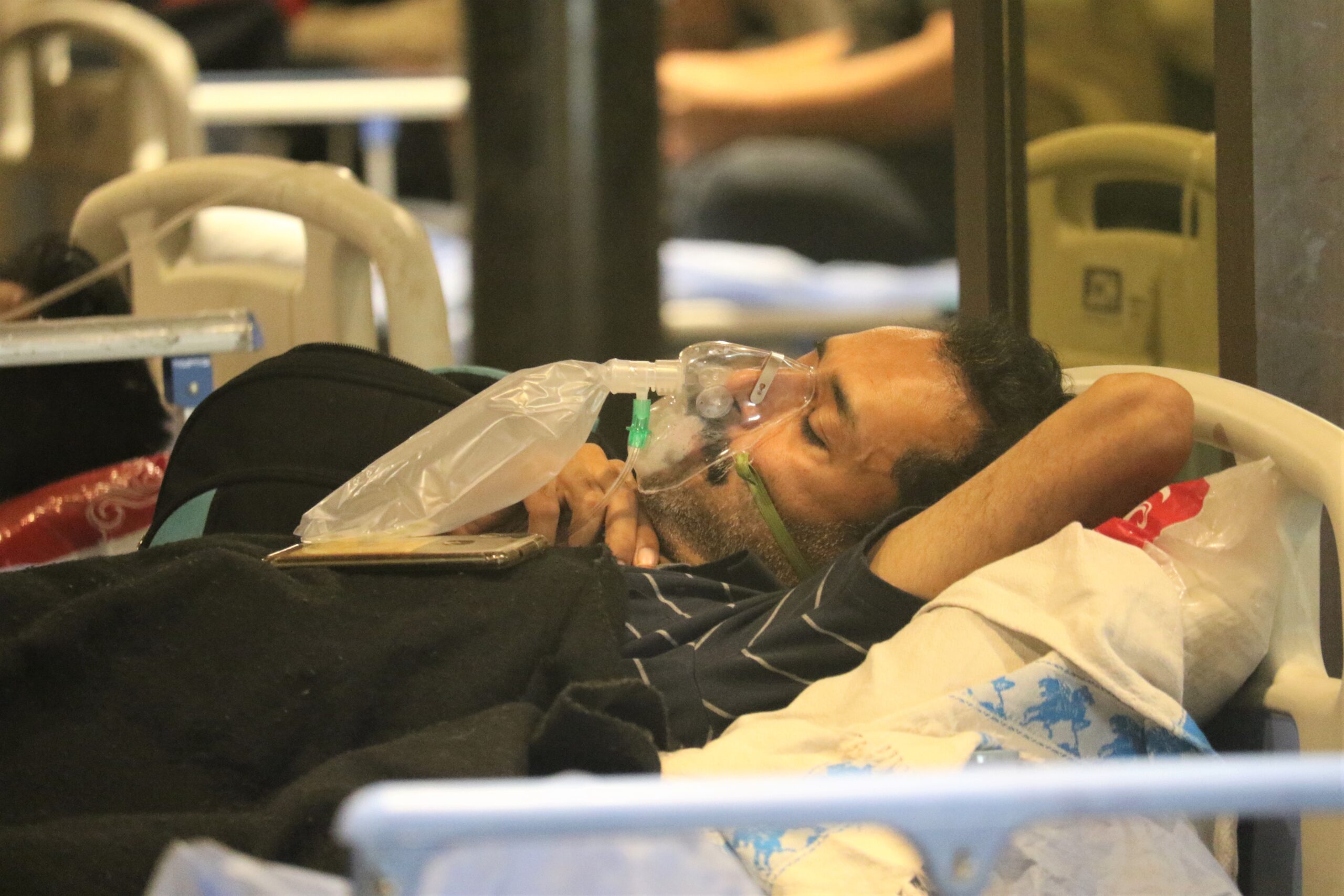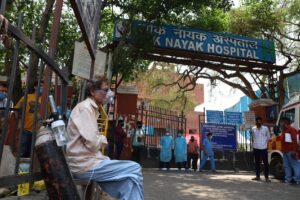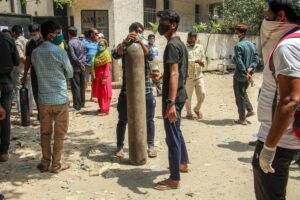Pandemic second wave rages on as Modi remains missing

According to World Bank, in 2017, India had just about 0.5 beds per 1000 persons, putting it in the bottom15 of over 190 nations in terms of hospital beds. (MIG photos/Aman Kanojiya)
The last two weeks have been the bloodiest for India since the coronavirus pandemic hit the country in February 2020. Practically every single day, new highs are being reported, both in fresh daily infections as well as in death toll due to the pandemic, with over 400,000 new cases and nearly 4000 deaths reported daily.
Ever since the second wave of the pandemic picked up pace over two months ago, the entire healthcare sector seems to have collapsed totally. Not just in the rural areas which are anyway severely under-serviced by healthcare sector, but also the best of the cities and even the national capital New Delhi where social media handles have been flooded with desperate requests for assistance by the next of the kin of those infected or bearing symptoms of the virus. April has seen a colossal disaster unfold over the entire country, reflecting total incompetence of the government headed by Prime Minister Narendra Modi, who has simply disappeared from the scene as his government continues to fumble and stumble at every step instead of trying to come to grips with managing the unprecedented crisis that India has found itself in.
Not only healthcare experts, but even the common persons now realise that the government has literally frittered away an entire year instead of preparing for the inevitable second wave of the pandemic. The results of this incompetence and failure have been visible across the media and social media. So large is the disaster that even the government-friendly media has been forced to report the bloodbath on display and criticise, at least timidly, the government’s unresponsiveness in face of the humanitarian crisis.

Family members say that the government failed miserable in tackling the second wave (MIG photos/Aman Kanojiya)
Starting with long delays in getting Covid-19 test results from the laboratories to beds in hospitals even for the most critical patients and on to supplies of oxygen, drugs and vaccines, there is a mad scramble for all of these and much more as families of the affected persons run from pillar to post for everything that the patients need. So much so that there is a severe shortage of even crematoriums as the number of dead has jumped multifold over the normal rate every day.
Testing facilities
The government has flopped at the first stage of fighting the virus – testing facilities. According to Indian Council for Medical Research, as of April 19, 2021, the entire country had only 1,423 testing facilities capable of carrying out RT-PCR tests which has become a global benchmark for Covid19 testing. To put it in perspective, that would be one lab for almost one million people. No wonder, now when the demand for tests is extremely high and not even reached its peak, laboratories are just unable to handle the pressure, making people wait for days or even weeks for even getting an appointment for the test and subsequently any number of days for getting the results.

According to ICMR, as of April 19, 2021, India had only 1,423 testing facilities capable of carrying out RT-PCR tests(MIG photos/Aman Kanojiya)
So bad is the situation, that even senior doctors working in hospitals have been seeking help in getting themselves tested. Your correspondent needed a test for travelling and the travel had to be cancelled as almost a month later, he is still is waiting for results. In some labs, entirely untrained staff like security guards or even support staff who clean or serve in the pantry have been conducting the tests, vitiating the entire process.
On May 5, with no respite in sight and labs still running way beyond their capacity, the ICMR issued fresh guidelines exempting several categories of people from mandatory tests. These include domestic travellers, people who have spent 10 days in isolation or those getting discharged from hospitals. The modified rules may cut the load on labs, but could easily boomerang especially since hospitals are indeed the first place for contamination and a self-isolation for a Covid-19 patient is no guarantee that the infection is over.
Hospitals horrors
If testing has become a huge challenge, the situation of those who need hospitalisation is nothing short of a horror film or nightmarish. Hundreds of stories from all corners of the country have appeared in various media and the social media about people carrying their relatives from one hospital to another for days to be able to find a bed for admission. Media is replete with images of patients lying in their cars or ambulances or simply on the street outside the hospital, waiting to get inside, or those fortunate enough to be admitted, lying on the floor or stretchers in the absence of any available beds. Practically everyday, dozens of reports emerge from all around of people who lost their kin while searching for hospitals.

With no more beds hospital staff keep patients waiting outside the hospital (MIG photos/Aman Kanojiya)
Finding a suitable hospital has always been a challenge in India as historically the country has severely underinvested in healthcare. Indian government has invested less than 1.30 pc of the country’s GDP on public healthcare forcing even those who cannot afford it to turn to private sector for their treatment. Per capita expenditure on public health in India is INR 1657, which is half of what Indonesia spends and a third of Sri Lanka.
According to the World Bank, in 2017, India had just about 0.5 beds per 1000 persons, putting it in the bottom 15 of over 190 nations in terms of hospital beds. Hospitalisation is also the primary cause of Indians becoming indebted. About 55 million Indians were pushed into poverty in a single year due to patient- care costs, as per a study by the Public Health Foundation of India. Unaffordability of costs is one of the main reasons behind low hospitalisation even in serious cases, which some studies place at under 10 pc of the need for hospitalisation.
Not only did the government not create any new medical facilities on a permanent basis since the outbreak, but it also hurriedly wound up the emergency facilities that had been created last year for Covid-19 patients. As a result, be it the most modern cities like Delhi or Bengaluru or the rural areas of Uttar Pradesh, Madhya Pradesh or Bihar, on any given day, hundreds if not thousands struggle to get a bed in any hospital that would take care of them or their loved ones.
Gasping for breath
Even more challenging than finding a hospital bed, unfortunate Indians have discovered since March 2021, is finding medical oxygen. In heart-rending scenes never seen before anywhere in the world, thousands of people have been moving around with large oxygen cylinders, waiting for days in serpentine queues outside the few refilling stations, with the hope of getting just a few litres of the most vital element needed by humans for survival.
Kayam Raza, a resident of Jaitpur Khadda Colony has been waiting in the queue since morning to get his oxygen cylinder refilled. He could not get his 70-year-old mother admitted in any hospital and has been waiting to just arrange for a refill of his oxygen cylinder. “We somehow arranged two cylinders and if one is empty, we use the other cylinder. We waited in the queue for hours. I have been here the whole night, still I couldn’t get anything. The government is doing nothing. We are treating my mother at home as we are not getting a bed in any hospital,” says Raza.

People say they have to wait outside the refill centre for more than two days with dozens of empty cylinders (MIG photos/Aman Kanojiya)
Raza is hardly the only one desperately seeking a refill of oxygen to save a loved one. Outside the factory of Vaibhav Oxygen, a refilling plant at Mohan Estate industrial area in New Delhi, a large crowd has been gathering every day, round the clock hoping to get just the amount that their family member would need. Krishan Kumar, owner of Vaibhav Oxygen, that has been operating since 1997, squarely blames the government for the collosal mismanagement. “Their duty is to provide liquid oxygen to us. They have failed. Their planning has failed. No one is responding. I have put all the numbers in front of the gate, but they are not helping us to provide liquid oxygen. We can feed up to 20 tonnes per day. But we have not received any supply since two days. If we don’t get the supplies, how are we supposed to refill. No officers are ready to reply. It is a collapse of system. Last year there was no problem, now it is 100 pc problem. No one is ready to help in any way. The government has made it really complex and the supply has finished,” says Kumar.
Indeed, there has been an open battle between the Delhi government and Modi government over oxygen supplies, which, like vaccines and Covid-19 drugs, have been entirely controlled by the central government. While Delhi chief minister Arvind Kejriwal says Delhi needs about 790 tonnes of oxygen every day, for many days the supply had been less than a third of that, leading to deaths of several dozen patients in the most upscale hospitals that also ran out of oxygen. This morbid figure does not include hundreds of others who died gasping for breath on the streets, either outside or enroute to hospitals. Many hospitals had put notices at their gates saying they could not take any patients due to lack of oxygen or that only those patients would be admitted that came equipped with their own supplies.
So dramatic has been the situation in Delhi and dozens of other cities in the country that the courts have gotten involved and Delhi High Court even issued a contempt of court notice to the Central government for not following its order to supply the requisite amount of oxygen to Delhi. Even the Supreme Court has now mandated the government to create a buffer stock of oxygen to deal with future needs, including the ‘inevitable third wave’ that the top scientific advisor to Modi has talked of recently.
World’s largest vaccination drive, but where are the vaccines?
One of the best ways to tackle the pandemic is also one of the rare areas where India is the world’s strongest player – vaccines. India produces 60 pc of all vaccines made in the world and Pune-based Serum Institute is manufacturing the AstraZeneca vaccine, while another firm Bharat Biotech has developed Covaxin, the government has completely flopped in managing the vaccination programme as well.
India was one of the last major nations to launch vaccinations, on January 16, 2021, but even then instead of ramping up vaccinations rapidly, India’s vaccination drive has been moving in bits and pieces, amidst fumbles and stumbles. Keeping an iron grip on who gets vaccinated where and when, Modi’s incompetent government has gone about vaccination in an entirely haphazard manner. Not ordering enough from its home grown vaccine makers or even as the world was scrambling for vaccines, India did not permit the import and use of vaccines made overseas be it Pfizer, Moderna, Sputnik or Sinovac, fully knowing that there is a significant time lag between allowing the use of vaccines in a country to the placement of orders and finally be with hospitals to use on patients. It would be months, if not an entire year, before they become available for us.

By May 5, India had administered 13.63 doses per 100 persons, lower than even the global average of 15.45, miles behind US that is at 75 doses per 100 persons and 81 in the UK (MIG photos/Aman Kanojiya)
Though it says it will fully vaccinate 300 million persons by July, so far the government has reportedly ordered only 170 million vaccines from the Indian firms, most of which would be delivered only from the next month onwards. This has led to an entirely avoidable slowdown in the vaccination drive, just at the time when the murderous second wave has led to a sharp spike in demand for the vaccines.
The demand is so high that on May 1, when government allowed 18-44 year olds to get vaccinated, the registration systems crashed repeatedly. But there are just not enough vaccines to go around. As a result, the vaccination has slowed down considerably since April 30. By this date, India had administered 152 million doses, as against 240 million by the United States and 265 million in China, the two countries that lead the world in total doses administered so far.
By May 5, the US had jumped to almost 250 million doses and China had raced ahead to almost 290 million. India, with its self-touted but untrue claim of carrying out world’s largest vaccination drive, had crawled to about 160 million doses or about 1.6 million doses each day as against 5 million doses every day by China.
On per capita basis, India lags behind not just the US and China, but a large number of nations. By May 5, India had administered 13.63 doses per 100 persons, lower than even the global average of 15.45 and miles behind United States that is at 75 doses per 100 persons and 81 in the UK.
Mystery of missing Modi
Almost since the beginning of the second wave, the Prime Minister has remained totally silent about the crisis. First, for several weeks, he proactively campaigned all over the country, breaking his own rules and the country’s laws on large gatherings, wearing masks or social distancing, pretending all the while that there was no crisis anywhere in the country. He also did not put any restrictions on the Maha Kumbh Mela, even though there were more than adequate warnings about the super spreader that it was. His party and cabinet members followed suite in campaigning blindly, violating all principles of socially responsible behaviour.
It was only when the Bengal election campaigning was almost over that Modi even acknowledged that a crisis had gripped the country. But after one address, he has again gone into hibernation, leaving the common citizens to deal with the crisis on their own and fend everything for themselves. Fortunately, hundreds of NGOs and several celebrities have taken up the cause and are trying to help as best as they can.
But all the levers of power and the control over much-needed supplies lie with the central government, or in the current system, with Modi himself. In his usual, highly opaque style of functioning, there is no clarity on any of the desperately needed supplies, including the tonnes of foreign aid that India had been obliged to beg for, from any country that could or would help the self-styled ‘Vishwa Guru’ or the ‘Pharmacy of the World’. Though supplies like oxygen, vaccines or other drugs are desperately needed, from an hour to the next, by thousands of hospitals dealing with the pandemic all over the country, the central government has neither shown any alacrity in dealing with the emergency, nor have they been transparent.
It has been several days, even more than a week, since the first lot of foreign aid was received, but yet, till today, the Centre has used obfuscation instead of clarity on where this aid has gone or where it will be deployed and when.
Many observers, including leading foreign media, have called out Modi for his remarkable ineptitude and callousness in dealing with the pandemic, with some going all the way and comparing his handling of the second wave to the British colonial government’s poor response to the famine which had hit Bengal in 1943 and in which nearly three million people had perished.
A careful marketing person that he is, Narendra Modi had begun an ambitious project to reconstruct government offices, Prime Minister’s residence and the Parliament in order to leave these permanent markers as the legacy of the ‘Modi-Era’. That project, whose budgeted cost is INR 105 billion, has been launched aggressively, pandemic or second wave notwithstanding.
But Modi’s legacy is already written. His callousness, complacence and incompetence in dealing with the pandemic. No amount of sparkling new buildings, large temples or giant statues can hide the misery and pain that he has unleashed on the people of India through his disastrous response to the pandemic.









